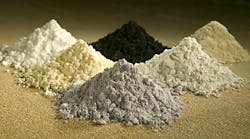TOKYO -- Japan on Saturday said it had won the rights to explore for cobalt-rich crusts in the Pacific, a move that could reduce its dependence on China for rare metals.
The government said the International Seabed Authority (ISA) had approved Japan's plan to probe a 3,000-square-kilometre area beneath international waters off the isolated Japanese coral atoll of Minamitorishima.
The area is located 600 kilometers (375 miles) off the atoll which lies 1,850 kilometers south of Tokyo.
The Japan Oil, Gas and Metals National Corporation, acting on the government's behalf, is due to sign a formal contract with the ISA covering 15 years of exploration rights.
Cobalt-rich crusts are presumed to cover the seabed between 1,000 and 2,000 meters down, containing such rare metals as manganese, cobalt, nickel and platinum, according to the statement.
Resources-poor Japan needs the metals for its high-tech components, including lithium-ion batteries and automobile engines.
China, the world's leading supplier of rare metals and rare earths, has used its position as diplomatic leverage at a time when it is locked in a row with Japan over Tokyo-controlled islands in the East China Sea.
In 2010, China restricted rare-earth exports when Japan arrested the captain of a Chinese trawler that was involved in a run-in with two Japanese coastguard cutters trying to coax it away from the disputed Senkaku Islands, claimed by China which calls them Diaoyu.
Economy, Trade and Industry Minister Toshimitsu Motegi said the initial approval of the exploration plan is "extremely significant as it can enhance the possibility of Japan's resources development."
Japan last obtained exclusive rights to explore the seabed for minerals under international waters in 1987, for manganese nodules in an area southeast of Hawaii, the statement said.
But with the nodules scattered at least 4,000 metere below sea level, development has yet to begin, the business daily Nikkei said.
The ISA was established by the UN Law of the Sea Convention to organize and control all mineral-related activities beneath international waters.
Copyright Agence France-Presse, 2013




